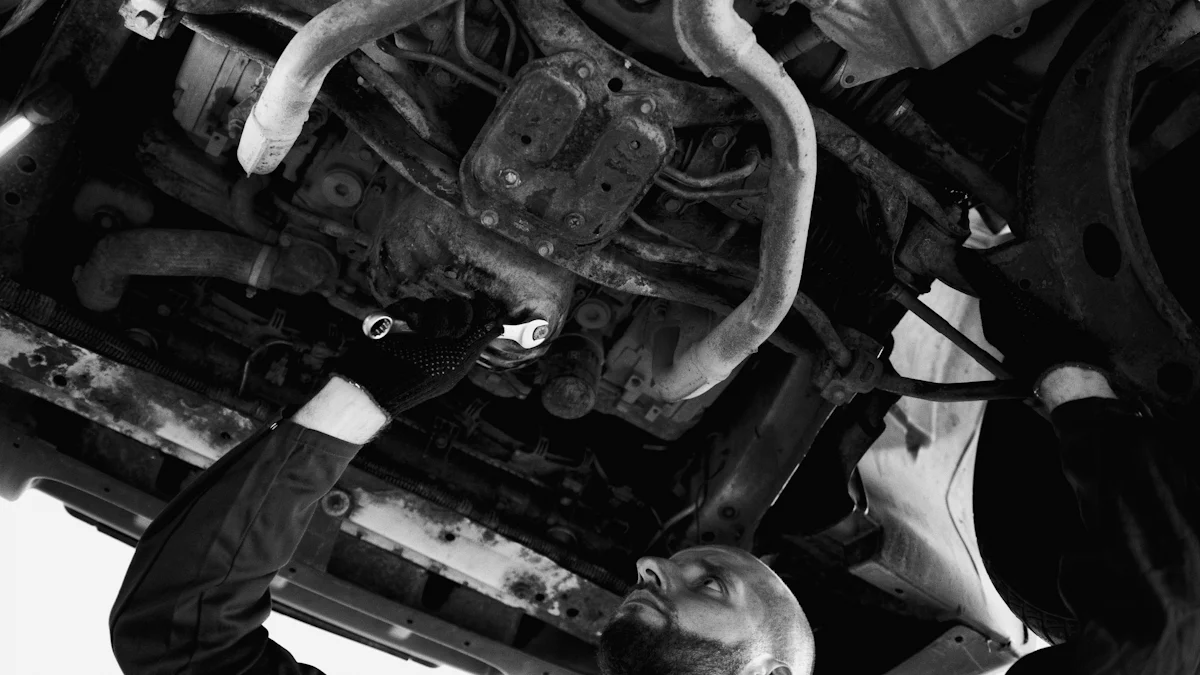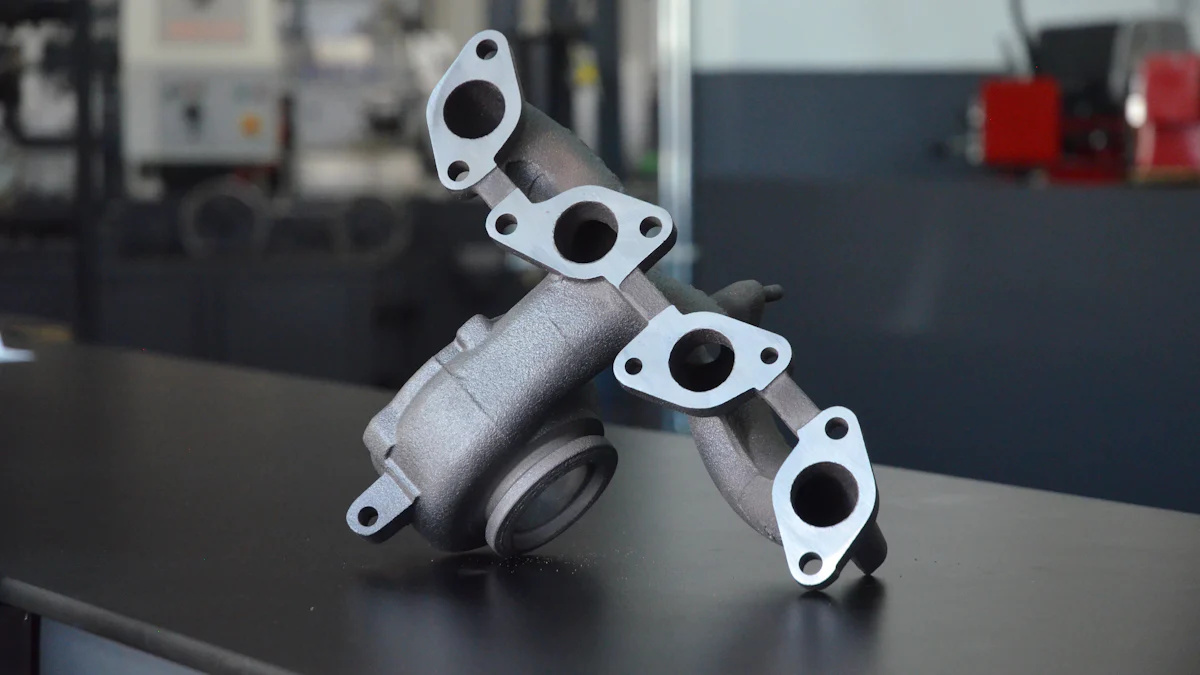
Maintaining the 7.3 IDI exhaust manifold is crucial for optimal engine performance. Addressing issues promptly ensures smooth operation and longevity. Common problems like leaks demand immediate attention to avoid further complications. This blog delves into identifying symptoms, root causes, and effective fixes for Engine Exhaust Manifold issues. By understanding these aspects, enthusiasts can proactively preserve their vehicle’s functionality.
Common Issues with 7.3 IDI Exhaust Manifold
Leaking 7.3 IDI exhaust manifold can lead to various problems that impact the vehicle’s performance. By recognizing the signs of a faulty Engine Exhaust Manifold, owners can take proactive steps to address these issues promptly.
Symptoms of Leaking Exhaust Manifold
Ticking Noises
When a 7.3 IDI exhaust manifold develops leaks, it often manifests through noticeable ticking noises emanating from the engine compartment. These sounds indicate that there is a disruption in the proper functioning of the manifold, requiring immediate attention to prevent further damage.
Check Engine Light
Another common symptom of a leaking Engine Exhaust Manifold is the illumination of the check engine light on the dashboard. This warning signal alerts drivers to potential issues with the exhaust system, prompting them to investigate and resolve the underlying cause promptly.
Odors in the Exhaust
Owners may detect unusual odors coming from the vehicle’s exhaust when there are leaks in the 7.3 IDI exhaust manifold. These odors can be noxious and indicate that exhaust gases are not being properly contained within the system, highlighting the need for thorough inspection and repair.
Visible Damage
Inspecting the Engine Exhaust Manifold visually can reveal signs of damage such as cracks, rust, or warping. These visible indications point towards structural weaknesses in the manifold that compromise its functionality and necessitate immediate remediation to prevent further deterioration.
Causes of Exhaust Manifold Problems
Heat Cycles
The repeated heating and cooling cycles experienced by the 7.3 IDI exhaust manifold during engine operation can contribute to metal fatigue over time. These fluctuations in temperature cause expansion and contraction, leading to stress on the manifold that may result in cracks or leaks.
Poor Installation
Inadequate installation procedures or using incorrect fastening techniques when fitting the Engine Exhaust Manifold can create vulnerabilities in its structure. Improper alignment or securing of components can lead to gaps where leaks may occur, emphasizing the importance of precise installation practices.
Material Fatigue
The materials used in manufacturing 7.3 IDI exhaust manifolds are subjected to extreme conditions within the engine bay, causing wear and degradation over extended periods. Material fatigue weakens the integrity of the manifold, making it susceptible to cracks, fractures, or other forms of damage.
Tools and Kits for Fixing 7.3 IDI Exhaust Manifold

When it comes to addressing issues with the 7.3 IDI exhaust manifold, having the right tools and repair kits is essential for a successful repair process. Proper equipment ensures precision and efficiency in fixing Engine Exhaust Manifold problems, allowing enthusiasts to maintain their vehicles effectively.
Essential Tools
Drill and Drill Bits
To begin the repair process, a high-quality drill and compatible drill bits are indispensable. These tools enable users to accurately create holes for various repair procedures on the 7.3 IDI exhaust manifold without causing damage or compromising the integrity of surrounding components.
Wrenches and Sockets
Having a set of reliable wrenches and sockets is crucial for disassembling and reassembling components during Engine Exhaust Manifold repairs. Different sizes may be required based on the specific bolts and fasteners involved, ensuring a secure fit and proper torque application.
Torque Wrench
A torque wrench is a precision tool that allows users to tighten bolts to manufacturer-specified levels without over-torquing or under-torquing. This ensures that all connections on the 7.3 IDI exhaust manifold are secure, minimizing the risk of leaks or structural issues post-repair.
Recommended Repair Kits
Lisle 72350 Manifold Drill Template
The Lisle 72350 Manifold Drill Template is a specialized tool designed for removing broken bolts from the Engine Exhaust Manifold without causing damage to the cylinder head. This template provides precise guidance for drilling out broken bolts, streamlining the repair process and reducing the risk of complications.
Ford 7.3 L Power Stroke Exhaust Manifold Broken Bolt Repair Kit
For owners dealing with broken bolts or damaged fasteners on their 7.3 IDI exhaust manifold, the Ford 7.3 L Power Stroke Exhaust Manifold Broken Bolt Repair Kit offers a comprehensive solution. This kit includes all necessary components for efficiently repairing broken bolts, saving time and effort while ensuring a reliable fix.
By utilizing these essential tools and recommended repair kits, enthusiasts can tackle 7.3 IDI exhaust manifold issues effectively, restoring optimal performance to their vehicles with confidence.
Step-by-Step Fixes for 7.3 IDI Exhaust Manifold

Removing Broken Bolts
To initiate the repair process for the 7.3 IDI exhaust manifold, the first step involves addressing broken bolts effectively to ensure a secure and reliable fix.
Preparation
- Prepare the necessary tools and equipment in a well-lit workspace conducive to intricate repairs.
- Organize the workspace by clearing any clutter that may hinder access to the Engine Exhaust Manifold.
- Inspect the area around the broken bolts to assess the extent of damage and plan the repair approach accordingly.
Drilling Out the Broken Bolt
- Select an appropriate drill bit size based on the specifications of the broken bolt for precise drilling.
- Securely fasten the drill bit into a high-quality drill, ensuring stability during operation.
- Carefully drill into the center of the broken bolt with steady pressure, avoiding unnecessary force that may cause further damage.
- Monitor progress closely to prevent over-drilling and maintain control over the extraction process.
Installing New Bolts
- Acquire fresh OEM bolts compatible with the 7.3 IDI exhaust manifold, ensuring proper fitment for optimal performance.
- Position each new bolt accurately in its designated location within the manifold, aligning them securely for a snug fit.
- Tighten each bolt gradually using a torque wrench to manufacturer-specified levels, preventing under or over-torquing that could compromise integrity.
Replacing the Exhaust Manifold
After successfully addressing broken bolts, proceeding with replacing the entire exhaust manifold is crucial to restore functionality and prevent future issues.
Removing Old Manifold
- Disconnect all components attached to the existing manifold, such as sensors and heat shields, with precision to avoid damage.
- Unbolt the old manifold systematically, starting from one end and progressing methodically across all fasteners.
- Lift off the old manifold carefully once all bolts are removed, ensuring no residual connections impede its removal.
Installing New Manifold
- Cleanse the engine block surface thoroughly to remove any debris or residue that may affect sealing with precision.
- Position the new exhaust manifold onto alignment studs or guides, verifying proper orientation before securing it in place.
- Securely fasten each bolt in a crisscross pattern to evenly distribute pressure and ensure a tight seal against leaks.
Applying Anti-Seize to Bolts
- Prioritize applying a metal fortified anti-seize compound on each bolt thread before installation for enhanced protection against corrosion and seizing.
- Use a minimal amount of anti-seize compound on each bolt thread to prevent excess material from interfering with torque application.
3 .Ensure uniform coverage of anti-seize compound on all bolts to promote longevity and ease of future maintenance efforts.
Preventive Measures for 7.3 IDI Exhaust Manifold
Regular Maintenance
Inspections
Regular maintenance of the 7.3 IDI exhaust manifold is paramount to ensure optimal performance and longevity of the vehicle’s exhaust system. By conducting routine inspections, owners can proactively identify potential issues and address them before they escalate into more significant problems.
- Schedule periodic inspections to assess the condition of the Engine Exhaust Manifold.
- Use a flashlight to examine the manifold for any signs of leaks, cracks, or corrosion.
- Check for loose bolts or fasteners that may compromise the integrity of the manifold.
- Inspect the surrounding components for heat damage or discoloration, indicating possible exhaust leaks.
Maintaining a proactive approach through regular inspections allows owners to detect and resolve minor issues promptly, preventing extensive damage to the 7.3 IDI exhaust manifold.
Tightening Bolts
Properly securing bolts on the Engine Exhaust Manifold is crucial to prevent leaks and maintain structural integrity. Over time, vibrations and thermal cycles can cause bolts to loosen, leading to potential exhaust leaks. By periodically tightening bolts, owners can ensure a secure connection and minimize the risk of manifold-related issues.
- Use a torque wrench to tighten bolts on the manifold to manufacturer-recommended specifications.
- Follow a cross-pattern tightening sequence to evenly distribute pressure across all bolts.
- Check bolt tightness after initial installation and subsequent engine operation to verify stability.
- Apply a metal fortified anti-seize compound on bolt threads before re-tightening for added protection against corrosion.
By incorporating regular bolt tightening into maintenance routines, owners can safeguard the 7.3 IDI exhaust manifold against leaks and maintain optimal performance over time.
Upgrades and Improvements
High-Quality Manifolds
Upgrading to high-quality aftermarket manifolds can enhance the durability and performance of the 7.3 IDI exhaust system. Premium manifolds are often constructed from robust materials that withstand high temperatures and mechanical stress better than stock components. By investing in quality manifolds, owners can improve exhaust flow efficiency and reduce the risk of leaks or failures.
- Consider upgrading to stainless steel or cast iron manifolds for increased durability.
- Opt for mandrel-bent tubing designs that promote smoother exhaust gas flow.
- Choose manifolds with reinforced flanges and welds for enhanced structural integrity.
- Consult with automotive experts or manufacturers like Werkwell for recommendations on compatible high-quality manifolds.
By upgrading to high-quality manifolds designed specifically for the 7.3 IDI engine, owners can optimize exhaust system performance while minimizing maintenance requirements.
Metal Fortified Anti-Seize
Applying a metal fortified anti-seize compound during maintenance tasks offers long-term benefits for preserving the integrity of the Engine Exhaust Manifold. This specialized compound creates a protective barrier between metal surfaces, reducing friction and preventing corrosion that could lead to bolt seizing or thread damage over time.
- Use a metal fortified anti-seize compound with high temperature resistance for exhaust applications.
- Apply a thin layer of anti-seize on bolt threads before installation or reassembly procedures.
- Ensure uniform coverage across all threaded connections on the manifold assembly.
- Reapply anti-seize during scheduled maintenance intervals to maintain its protective properties effectively.
By incorporating metal fortified anti-seize into maintenance practices, owners can prolong the lifespan of their 7.3 IDI exhaust manifold, mitigate corrosion risks, and facilitate future disassembly tasks with ease.
- Emphasize the critical nature of promptly addressing any issues with the 7.3 IDI exhaust manifold to maintain peak performance.
- Summarize the detailed steps for fixing and preventing problems, ensuring a comprehensive approach to exhaust system maintenance.
- Encourage enthusiasts to prioritize regular upkeep of their 7.3 IDI exhaust manifold for sustained efficiency and longevity.
Maintaining vigilance and care towards the exhaust manifold guarantees a reliable driving experience and prolonged engine health.
Post time: Jun-19-2024



